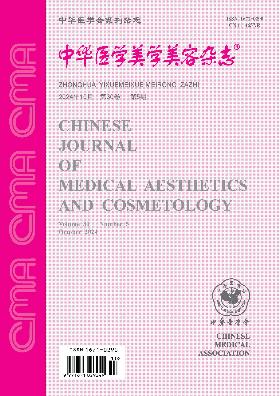Effect of a novel rotating advancing method on reconstruction of nasal lip symmetry
引用次数: 0
Abstract
Objective To introduce the application of muscle reconstruction torque balance theory in the new rotating advancement method, and to evaluate the postoperative effect of this method on the nasal lip symmetry of patients with unilateral cleft lip. Methods A total of 62 patients with unilateral cleft lip were treated with two-dimensional radiography of posterior anterior position and mandibular chin position before, immediately and one-year follow-up. Five indexes representing the symmetry of lip and nose were measured by photoshop software. T test was used to compare the measurement results of each angle or distance index at different times. P<0.05 showed that there was significant difference between the two groups. Results All the patients who were treated with the technique described in this study obtained satisfactory lip and nasal symmetry immediately and one-year follow-up. Conclusions The new theory of oral muscle strength balance is a new breakthrough on the basis of the application of muscle reconstruction. It is suitable for the primary repairment of unilateral lip, and good results have been obtained. Key words: Cleft lip; Orthopedic procedures; Muscle reconstruction; Muscle strength balance; Torque; New rotating advancement method一种新的旋转推进方法对鼻唇对称性重建的影响
目的介绍肌肉重建力矩平衡理论在旋转推进新方法中的应用,并评价该方法对单侧唇裂患者鼻唇对称性的影响。方法对62例单侧唇裂患者在术前、术后及术后随访1年,分别进行下颌前位和下颌前位二维x线片检查。用photoshop软件对代表唇鼻对称性的五项指标进行了测量。T检验用于比较不同时间的每个角度或距离指数的测量结果。P<0.05,两组比较有显著性差异。结果所有接受本研究所述技术治疗的患者立即获得了令人满意的唇鼻对称性,并进行了一年的随访。结论口腔肌力平衡新理论是在肌肉重建应用基础上的一个新突破。适用于单侧唇部的初次修复,效果良好。关键词:唇裂;骨科手术;肌肉重建;肌肉力量平衡;扭矩;新的旋转推进方法
本文章由计算机程序翻译,如有差异,请以英文原文为准。
求助全文
约1分钟内获得全文
求助全文
来源期刊
自引率
0.00%
发文量
4641
期刊介绍:
"Chinese Journal of Medical Aesthetics and Cosmetology" is a high-end academic journal focusing on the basic theoretical research and clinical application of medical aesthetics and cosmetology. In March 2002, it was included in the statistical source journals of Chinese scientific and technological papers of the Ministry of Science and Technology, and has been included in the full-text retrieval system of "China Journal Network", "Chinese Academic Journals (CD-ROM Edition)" and "China Academic Journals Comprehensive Evaluation Database". Publishes research and applications in cosmetic surgery, cosmetic dermatology, cosmetic dentistry, cosmetic internal medicine, physical cosmetology, drug cosmetology, traditional Chinese medicine cosmetology and beauty care. Columns include: clinical treatises, experimental research, medical aesthetics, experience summaries, case reports, technological innovations, reviews, lectures, etc.

 求助内容:
求助内容: 应助结果提醒方式:
应助结果提醒方式:


